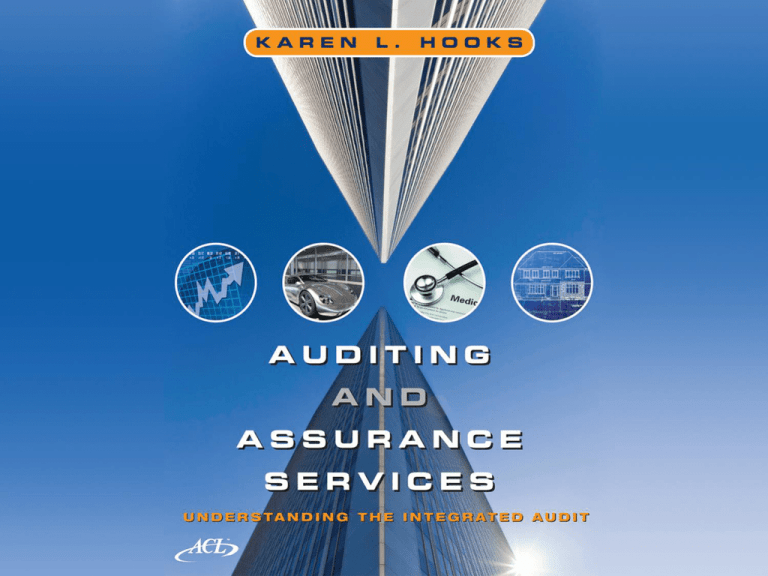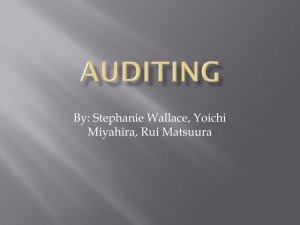
Chapter 15
Auditing Assets, Liabilities, and
Equity Related to the Financing
Cycle
Prepared by Richard J. Campbell
Copyright 2011, Wiley and Sons
Learning Objectives
1. Describe the activities, controls, accounting standards, and audit steps
for cash, near cash, and cash equivalents.
2. Describe the activities, transactions, controls, accounting standards, and
audit steps for investments.
3. Explain the audit processes for other comprehensive income and the
consolidation process.
4. Recognize important issues for auditing disclosures of assets in the
financing cycle.
5. Describe the activities, transactions, controls, accounting standards, and
audit steps for long-term debt and other long-term accounts.
6. Explain the audit processes for auditing pensions and postretirement
benefits and taxes.
Chapter 15-1
Learning Objectives
7. Recognize important issues for auditing disclosures of liabilities in the
financing cycle.
8. Describe the activities, transactions, controls, accounting standards, and
audit steps for equity accounts
9. Explain the audit processes for mergers and acquisitions, and retained
earnings.
10. Recognize important issues for auditing disclosures of equity in the
financing cycle.
11. Discuss the risks, accounting standards, and audit procedures for
related parties and related party transactions in the financing cycle.
Chapter 15-2
Cash and Near Cash
Common items considered near cash or cash equivalents
are certificates of deposit, United States Treasury bills, and
commercial paper.
The overall audit goal for cash and near cash is to
determine whether the amount is fairly presented in the
financial statements and the disclosure is adequate.
An important part of the audit of cash is to simultaneously
consider all bank accounts.
This simultaneous examination is needed because of the
risk that funds transferred between bank accounts might be
counted twice.
Chapter 15 -3
Learning Objective #1
Interbank Transfer Schedule
Chapter 15 -4
Learning Objective #1
Proof of Cash
Chapter 15 -5
Learning Objective #1
Investments
When the period of time before the funds need to be
disbursed is longer, a company typically puts the funds in a
different kind of investment with a greater earnings return
or yield.
Derivatives is a term used to describe certain types of
investments.
Derivatives are often the type of financial instruments used
as investments to hedge against business risks.
Equity security investments that represent a company’s
ownership interest in another business, or its rights related
to an ownership interest, can be marketable securities if
they are traded on a stock exchange.
Chapter 15 -6
Learning Objective #2
Key Terms for Fair Value
EXHIBIT 15-1
Chapter 15 -7
Learning Objective #2
Financial Assets and Financial Liabilities Eligible for the Fair Value Option
EXHIBIT 15-2
Chapter 15 -8
Learning Objective #2
Auditing Fair Value Measurements and Disclosures
EXHIBIT 15-3
Chapter 15 -9
Learning Objective #2
Information Used to Determine Fair Value
Chapter 15-10
Learning Objective #2
Examples of Controls and Related Tests for
Investments
EXHIBIT 15-4
Chapter 15-11
Learning Objective #2
Examples of Controls and Related Tests for
Investments
EXHIBIT 15-4
Chapter 15-12
Learning Objective #2
Examples of Controls and Related Tests for
Investments
EXHIBIT 15-4
Chapter 15-13
Learning Objective #2
Examples of Controls and Related Tests for
Investments
EXHIBIT 15-4
Chapter 15-14
Learning Objective #2
Examples of Controls and Related Tests for
Investments
EXHIBIT 15-4
Chapter 15-14
Learning Objective #2
Examples of Controls and Related Tests for
Investments
EXHIBIT 15-4
Chapter 15-16
Learning Objective #2
Summary of Tests Related to Sophisticated Financial
Instruments
EXHIBIT 15-5
Chapter 15-17
Learning Objective #2
Auditing Other Comprehensive Income
Comprehensive income is defined in FASB codification 22010, Comprehensive Income. It is also defined in FASB Concepts
Statement No. 6. Both describe it as a business enterprise’s
change in equity resulting from transactions and other
events from nonowner sources.
The auditor obtains information about OCI as a result of
auditing the changes in the related balance sheet accounts
that make up its components, for example, financial assets
and financial liabilities.
Chapter 15-18
Learning Objective #3
Auditing Disclosures
Those disclosure requirements are expected to result in the following:
a. Information to enable users of its financial statements to understand
management’s reasons for electing or partially electing the fair value
option
b. Information to enable users to understand how changes in fair values
affect earnings for the period
c. The same information about certain items (such as equity
investments and nonperforming loans) that would have been disclosed
if the fair value option had not been elected
d. Information to enable users to understand the differences between
fair values and contractual cash flows for certain items. (FASB
codification 825-10-50-24, 25)
Chapter 15-19
Learning Objective #4
Long-Term Debt
Most companies have long-term debt as a part of
their capital structures.
Important aspects of accounting for debt are:
Including all debt at the proper amounts
Classifying debt appropriately as long or short term
Providing the required presentation and disclosure
Chapter 15-20
Learning Objective #5
Examples of Controls and Related Tests for
Debt
EXHIBIT 15-6
Chapter 15-21
Learning Objective #5
Examples of Controls and Related Tests for
Debt
EXHIBIT 15-6
Chapter 15-22
Learning Objective #5
Examples of Controls and Related Tests for
Debt
EXHIBIT 15-6
Chapter 15-23
Learning Objective #5
Substantive Analytical Procedures
Chapter 15-24
Learning Objective #5
Examples of Tests of Details of Balances for Debt
EXHIBIT 15-7
Chapter 15-25
Learning Objective #5
Examples of Tests of Details of Balances for Debt
EXHIBIT 15-7
Chapter 15-26
Learning Objective #5
Examples of Tests of Details of Balances for Debt
EXHIBIT 15-7
Chapter 15-27
Learning Objective #5
Example of a Work Paper for the Audit of Debt
Chapter 15-28
Learning Objective #5
Auditing Pensions and Postretirement Benefits Accounts
Company financial statements report expenses and
liabilities related to pensions, postretirement benefits, and
postemployment benefits.
Generally, pensions can be defined benefit or defined
contribution plans.
Funded pension plans are often managed by a trust.
The trust itself is a separate entity from the company with
its own financial statements that must be audited
Chapter 15-29
Learning Objective #6
Examples of Steps in Auditing Pension Costs
EXHIBIT 15-8
Chapter 15 -30
Learning Objective #6
Auditing Taxes
Chapter 15 -31
Learning Objective #6
Auditing Disclosures
Disclosures for debt, pension and postretirement
benefits, and taxes are extensive and specified by
the accounting standards applicable to the
accounts.
Therefore, to audit the disclosure, the auditor
reads the information on the face of the financial
statements and in the notes.
Chapter 15 -32
Learning Objective #7
Equity Transactions and Activities
Execution and recordkeeping for equity transactions are
often outsourced.
In publicly traded companies, an outside registrar
determines that all stock a company issues complies with
its corporate charter.
To maintain a record of current stock owners, most publicly
traded companies contract with an outside stock transfer
agent.
Chapter 15 -33
Learning Objective #8
Ratios Related to Equity Accounts
Chapter 15 -34
Learning Objective #8
Examples of Tests of Details of Balances for
Equity Accounts
EXHIBIT 15-9
Chapter 15 -35
Learning Objective #8
Auditing Disclosures
The financial statements must disclose the number of
shares authorized, issued, and outstanding for each class of
stock.
FASB ASC 505-10-50, Equity Disclosure, requires entities to
disclose a summary of the pertinent rights and privileges of
outstanding securities.
Chapter 15 -36
Learning Objective #10
AUDITING RELATED PARTY TRANSACTIONS
Chapter 15 -37
Learning Objective #11
Identifying Transactions with Related Parties
EXHIBIT 15-10
Chapter 15 -38
Learning Objective #11
Red Flags for Related Party Transactions
EXHIBIT 15-11
Chapter 15 -39
Learning Objective #11
Review Question
After identifying related party transactions,
(a) the auditor assumes that the transactions
were arms length business transactions
unless the audit client provides evidence to
the contrary.
(b) the auditor assumes that the transactions were
outside of the ordinary course of business.
(c) the auditor must obtain evidence that the
transactions were on the same terms that arms
length transactions would be.
(d) the auditor must obtain evidence that the
transactions would have occurred at the same
amounts even if the parties were not related
Chapter 15-40
Review Question
When using the work of a specialist,
(a) the auditor is not responsible for anything the
specialist does.
(b) the auditor should understand the methods
and assumptions the specialist uses.
(c) the client must select the specialist or the
auditor is responsible for the work.
(d) the auditor may only select a specialist who is
certified.
Chapter 15-41
Review Question
For which of the following management
assertions about investments is the auditor
most likely to use a specialist?
(a) Existence
(b) Ownership
(c) Completeness
(d) Valuation
Chapter 15-42
Copyright
“Copyright © 2011 John Wiley & Sons, Inc. All rights reserved.
Reproduction or translation of this work beyond that permitted
in Section 117 of the 1976 United States Copyright Act without
the express written permission of the copyright owner is
unlawful. Request for further information should be addressed
to the Permissions Department, John Wiley & Sons, Inc. The
purchaser may make back-up copies for his/her own use only and
not for distribution or resale. The Publisher assumes no
responsibility for errors, omissions, or damages, caused by the
use of these programs or from the use of the information
contained herein.”






